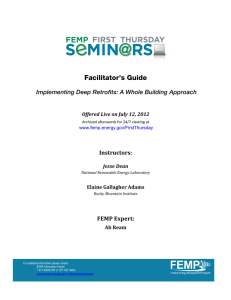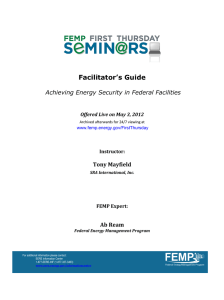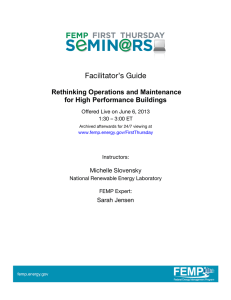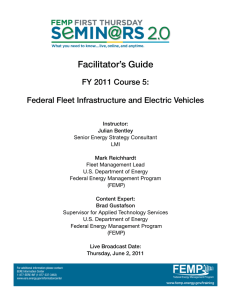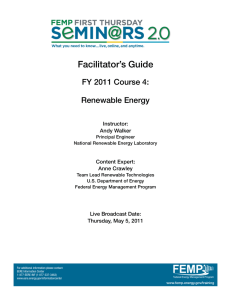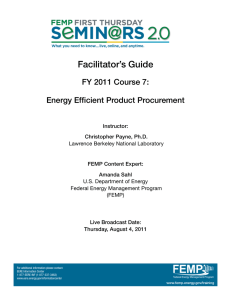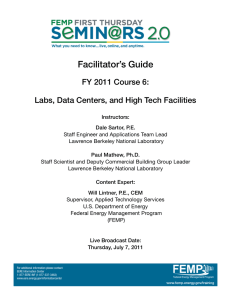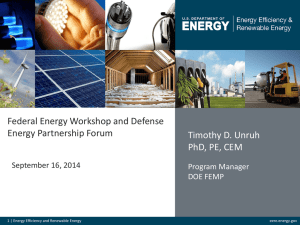Learner’s Guide Energy Efficient Product Procurement
advertisement
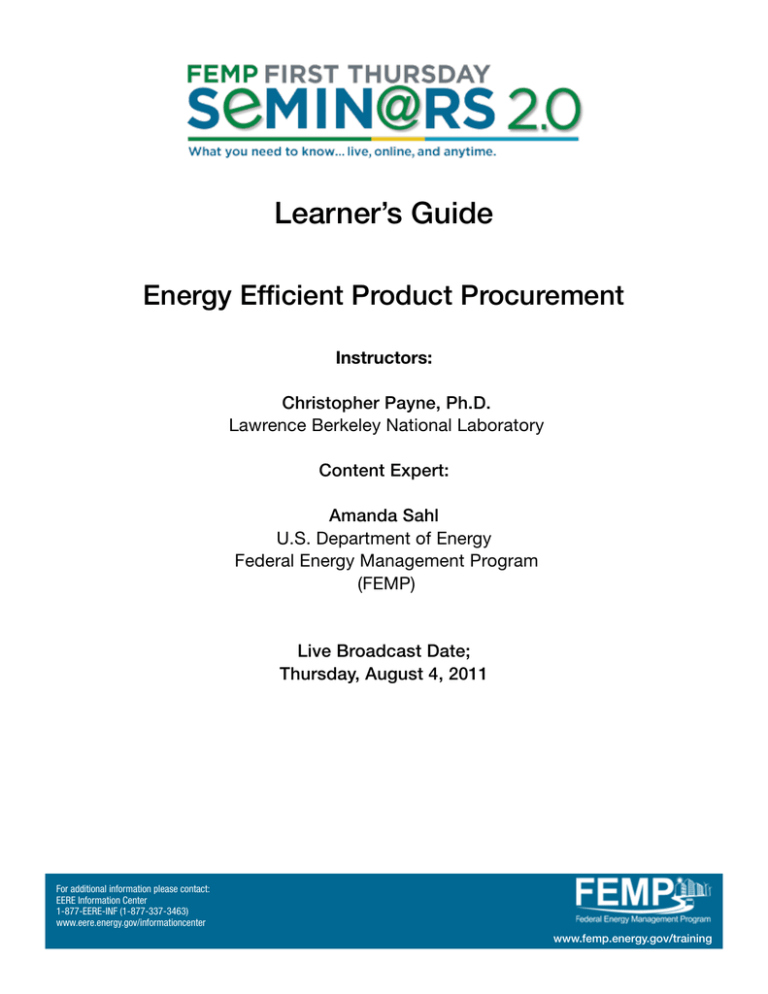
Learner’s Guide Energy Efficient Product Procurement Instructors: Christopher Payne, Ph.D. Lawrence Berkeley National Laboratory Content Expert: Amanda Sahl U.S. Department of Energy Federal Energy Management Program (FEMP) Live Broadcast Date; Thursday, August 4, 2011 For additional information please contact: EERE Information Center 1-877-EERE-INF (1-877-337-3463) www.eere.energy.gov/informationcenter www.femp.energy.gov/training Seminar: Energy Efficient Product Procurement Background on the FEMP First Thursday Seminars The First Thursday Seminars are designed for Federal Energy Managers but are open to anyone whose scope of responsibility involves influencing decisions to increase energy efficiency, conserve water resources, and meet other Federal sustainability goals. There are three ways to participate in the seminars. 1. Live streaming video available on the day of the event over the internet to a desktop computer or via a projection system in a conference room; 2. Digital and Analog Satellite downlink technology for group showings; and, 3. Archived streaming video available after the event over the Internet on a desktop computer or via a projection system in a conference room. To learn more about accessing specific seminars, access http://www.femp.energy.gov/firstthursday. Introduction The seminar “Energy Efficient Product Procurement” is being offered live on Thursday, August 4, 2011 at 1:30 pm Eastern Time. For access and other course information, access seminar’s landing page. The seminar is designed to give you up-to-date information on how to meet executive order and Federal Acquisition Regulation (FAR) requirements on purchasing FEMP designatedand ENERGY STAR products. The seminar will last 90 minutes. Learner Objectives After completing this seminar, the learner will: 1. Discuss the legal basis and benefits of the Energy Efficient Product Procurement programs; 2. Explain how FEMP identifies designated product categories and sets efficiency requirements for Federal procurement; 3. Explain how the ENERGY STAR® program functions and resources available to support you; 4. Describe the FEMP Standby Power program; and, 5. List FEMP resources to support you in making energy efficient product purchases. Asking Questions At the end of the seminar, there will be an opportunity for you to ask questions. You will be able to email, fax, or ask questions by phone. You may email or fax your questions anytime during the broadcast. You will be able to speak “live” with the instructor at the end of the presentation. The phone, fax, and email information will be posted on the screen during the seminar. During the live broadcast, ask questions by either: • Dialing the toll free number 800-775-3728 • Faxing questions to 865-381-0554 • Or by sending an email to FTS@energyworkshops.org. Upon Seminar Completion Each participant who registers for the training via FEMP Central or who signs a Roster (at a satellite broadcast location) will be sent an email with a link to the seminar evaluation and the open book quiz. If you do not have a Roster, they are available here. Please sign the Roster and scan/ email to ruleb@tds.net or Fax to 865-381-0554. Upon completion of the evaluation and the open book quiz, you will be able to print a course completion certificate for your records. For additional information please contact: EERE Information Center 1-877-EERE-INF (1-877-337-3463) www.eere.energy.gov/informationcenter www.femp.energy.gov/training Page 1 Additional Materials The materials in this section support the learning in the presentation. Resources for Your Use ENERGY STAR: www.energystar.gov/ FEMP Energy Efficient Product Purchasing: eere.energy.gov/femp/technologies/procuring_eeproducts.html FEMP Designated Product Categories: eere.energy.gov/femp/technologies/eep_purchasingspecs.html Glossary of Terms Acquisition Guidance and Efficiency Requirements (aka, Product Overview) - Define FEMP purchasing specifications. Annual Consumption - Annual consumption refers to the amount of electricity used in one year and is typically measured in kilowatt-hours (kWh). This information is available on your electricity bill or by contacting your energy provider. British Thermal Unit (Btu) - the amount of heat required to raise the temperature of one pound of water one degree Fahrenheit; equal to 252 calories. Carbon Dioxide - Carbon dioxide (CO2) is an atmospheric gas that is a major component of the carbon cycle. Although produced through natural processes, carbon dioxide is also released through human activities, such as the combustion of fossil fuels to produce electricity. Carbon dioxide is the predominate gas contributing to the greenhouse gases, and as such is known to contribute to climate change. Carbon Intensity - The amount of carbon by weight emitted per unit of energy consumed. A common measure of carbon intensity is weight of carbon per British thermal unit (Btu) of energy. When there is only one fossil fuel under consideration, the carbon intensity and the emissions coefficient are identical. When there are several fuels, carbon intensity is based on their combined emissions coefficients weighted by their energy consumption levels. Emerging technologies (ET) - Contemporary advances and innovation in various fields of technology. Various converging technologies have emerged in the technological convergence of different systems evolving towards similar goals. Energy - the capability of doing work; different forms of energy can be converted to other forms, but the total amount of energy remains the same. Energy audit - a survey that shows how much energy you use in your facility and help to identify energy efficiency measures. Energy conservation - any behavior that results in the use of less energy. Turning the lights off when you leave the room or buying more energy efficient products are both ways of conserving energy. Energy Efficiency - Refers to products or systems using less energy to do the same or better job than conventional products or systems. Energy efficiency saves energy, saves money on utility bills, and helps protect the environment by reducing the demand for electricity. For additional information please contact: EERE Information Center 1-877-EERE-INF (1-877-337-3463) www.eere.energy.gov/informationcenter www.femp.energy.gov/training Page 2 Energy intensity - the relative extent that energy is required for a process. Energy management - the sum of measures planned and carried out to achieve the objective of using the minimum possible energy while the comfort levels (in offices or dwellings) and the production rates (in factories) are maintained. To make an efficient use of the energy and, as a consequence, to save it, the actions are focused on: energy conservation, energy recovery, and energy substitution. Energy management control system (EMCS) - The Energy Management Control System (EMCS) is a computer-based means for controlling and monitoring heating, ventilation, air-conditioning (HVAC), energy use, and lighting systems. Energy savings performance contract (ESPC) - A contracting method in which the contractor provides capital to facilitate energy savings projects and maintains them in exchange for a portion of the energy savings generated. ENERGY STAR® - A United States government program jointly managed by the US Environmental Protection Agency and the Department of Energy in an attempt to reduce energy consumption and greenhouse gas emission by power plants. What began originally as a voluntary labeling program has grown in to one of the largest efforts worldwide to promote energy efficient consumer products. Energy Conservation Measure (ECM) - A building material or component whose use will affect the energy consumed for space heating, space cooling, domestic hot water or refrigeration. EPEAT - A system that helps purchasers evaluate, compare and select electronic products based on their environmental attributes. The system currently covers desktop and laptop computers, thin clients, workstations and computer monitors. Desktops, laptops and monitors that meet 23 required environmental performance criteria may be registered in EPEAT by their manufacturers in 40 countries worldwide. Registered products are rated Gold, Silver or Bronze depending on the percentage of 28 optional criteria they meet above the baseline criteria. EPEAT operates an ongoing verification program to assure the credibility of the registry. ESCO - Commercial business providing a broad range of comprehensive energy solutions including designs and implementation of energy savings projects, energy conservation, energy infrastructure outsourcing, power generation and energy supply, and risk management. Executive Order 13221: Energy Efficient Standby Power Devices - Executive Order (E.O.) 13221, Energy Efficient Standby Power Devices, calls for Federal agencies to purchase products that use minimal standby power when possible. Executive Order 13423: Strengthening Federal Environmental, Energy and Transportation calls for Federal agencies sets goals in the areas of energy efficiency, acquisition, renewable energy, toxics reductions, recycling, sustainable buildings, electronics stewardship, fleets, and water conservation. Executive Order 13514: Federal Leadership in Environmental, Energy, and Economic Performance was signed on October 5, 2009. It expanded upon the energy reduction and environmental performance requirements of E.O. 13423. Federal Acquisition Streamlining Act (FASA) of 1994 - The Federal Acquisition Streamlining Act of 1994 (FASA) made a number of changes in the way goods and services at, or below, $100,000 are acquired. The Act replaces the $25,000 threshold with a new “Simplified Acquisition Threshold” (SAT) of $100,000 once an agency (or procuring activity within the agency) have achieved certain electronic commerce (FACNET) capabilities, are using them and certify that they have met the criteria. Federal Energy Management Program (FEMP) - a program of the U.S. Department of Energy (DOE) that implements energy legislation and presidential directives. FEMP provides project financing, technical guidance and assistance, coordination and reporting, and new initiatives for the Federal government. It also helps Federal agencies identify the best technologies and technology demonstrations for their use. For additional information please contact: EERE Information Center 1-877-EERE-INF (1-877-337-3463) www.eere.energy.gov/informationcenter www.femp.energy.gov/training Page 3 Federal Financing Specialist (FFS) - FEMP’s Federal financing specialists (FFSs) help agencies get started with energy savings performance contract (ESPC) and other energy efficiency projects. FEMP Designated Product Categories (aka Covered Product Categories) - FEMP-Designated product categories define energy efficiency requirements that are in the upper 25% of their class in energy efficiency. FEMP-Designated products are not specific products. FEMP does not purchase, recognize, endorse, or otherwise identify specific products for Federal procurement. Instead, FEMP identifies required energy efficiency performance requirements for a category of products, which is typically an energy consumption level within the upper 25% of the product category. FEMP Product Energy Efficiency Requirements (aka, Efficiency Requirements) Greenhouse Gases (GHGs) - Gases in the Earth’s atmosphere that produce the greenhouse effect. Changes in the concentration of certain greenhouse gases, due to human activity such as fossil fuel burning, increase the risk of global climate change. Greenhouse gases include water vapor, carbon dioxide, methane, nitrous oxide, halogenated fluorocarbons, ozone, perfluorinated carbons, and hydro fluorocarbons. Investment-grade audit (IGA) - a procedure which may include, but is not limited to, a detailed analysis of energy cost savings and energy unit savings potential, building conditions, energy consuming equipment, and hours of use or occupancy for the purpose of confirming or revising technical and price proposals based on the preliminary energy survey. Kilowatt-hour - A kilowatt-hour (kWh) is a standard metric unit of measurement for electricity. Life cycle costs - For the purposes of energy efficiency product procurement, life cycle costs include both purchase price and operating costs. Measurement and verification (M&V) - A process of using measurement to reliably determine actual savings created within an individual facility by an energy management, energy conservation or energy efficiency project or program. As savings cannot be directly measured, the savings can be determined by comparing measured use before and after implementation of a project, making appropriate adjustments for changes in conditions. Megawatt-hour - A megawatt-hour (MWh) is equal to 1,000 kWh. • One kilowatt-hour (kW) is equal to 1,000 watt-hours (Wh). • One watt is the amount of power rate of one joule of work per second of time. Sustainability, sustainable - to create and maintain conditions, under which humans and nature can exist in productive harmony, that permit fulfilling the social, economic, and other requirements of present and future generations. Sustainable acquisition - refers to Federal requirements to purchase products with environmental and energy saving attributes. Also referred to as “green purchasing” or “sustainable purchasing.” Utility Energy Service Contracts (UESCs) - Utility energy service contracts offer Federal agencies an effective means to implement energy efficiency, renewable energy, and water efficiency projects. In a UESC, a utility arranges financing to cover the capital costs of the project, which are repaid over the contract term from cost savings generated by the energy efficiency measures. With this arrangement, agencies can implement energy improvements with no initial capital investment. The net cost to the Federal agency is minimal, and the agency saves time and resources by using the one-stop shopping provided by the utility. For additional information please contact: EERE Information Center 1-877-EERE-INF (1-877-337-3463) www.eere.energy.gov/informationcenter www.femp.energy.gov/training Page 4
